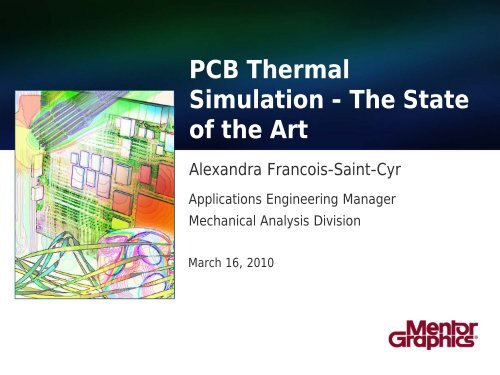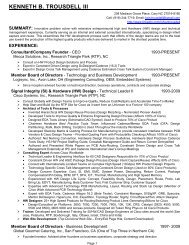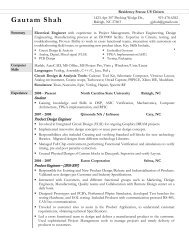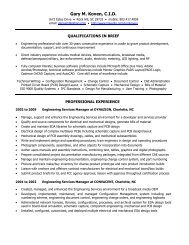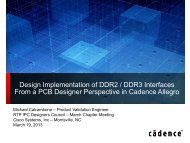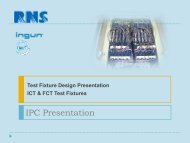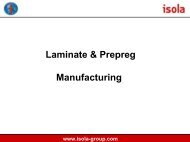PCB Thermal Simulation - RTP Designers Council
PCB Thermal Simulation - RTP Designers Council
PCB Thermal Simulation - RTP Designers Council
Create successful ePaper yourself
Turn your PDF publications into a flip-book with our unique Google optimized e-Paper software.
<strong>PCB</strong> <strong>Thermal</strong><br />
<strong>Simulation</strong> - The State<br />
of the Art<br />
Alexandra Francois-Saint-Cyr<br />
Applications Engineering Manager<br />
Mechanical Analysis Division<br />
March 16, 2010
2<br />
<strong>PCB</strong> <strong>Thermal</strong> <strong>Simulation</strong> –<br />
The State of the Art<br />
Agenda<br />
— Introduction to the Mentor Graphics Mechanical<br />
Analysis Division<br />
— <strong>PCB</strong> Design Challenges<br />
— Electronics Failures Related To Temperature<br />
— Heat Transfer 101<br />
— <strong>Thermal</strong> Design Tools Review<br />
— <strong>PCB</strong> <strong>Thermal</strong> <strong>Simulation</strong><br />
— Application Example<br />
— Assessing <strong>Thermal</strong> <strong>Simulation</strong> Accuracy<br />
© 2010 Mentor Graphics Corp. Company Confidential<br />
www.mentor.com
3<br />
About the Mentor Graphics<br />
Mechanical Analysis Division<br />
A new division formed in August 2008 after the<br />
acquisition of Flomerics by Mentor Graphics<br />
Focused on delivering analysis and simulation<br />
software and services for mechanical design<br />
Division headquarters: Hampton Court, London, UK<br />
Over 180 employees<br />
Development in UK, Moscow and Budapest<br />
Direct Sales and Support operations throughout the<br />
world<br />
© 2010 Mentor Graphics Corp. Company Confidential<br />
www.mentor.com
4<br />
Principal Lines of Business<br />
<strong>Thermal</strong> Design of Electronics<br />
— FloTHERM = clear market leader<br />
— 75% of division’s revenue<br />
Concurrent Computational Fluid<br />
Dynamics (CFD)<br />
— FloEFD - a different breed of CFD<br />
software that is fully embedded<br />
in the mechanical design<br />
environment<br />
Building Heating & Ventilation<br />
— Optimize airflow, temperature<br />
distribution and contamination<br />
control in and around buildings<br />
and in HVAC equipment<br />
— Data Center Cooling is a<br />
particular focus<br />
© 2010 Mentor Graphics Corp. Company Confidential<br />
www.mentor.com
7<br />
Typical Design Constraints<br />
Operate at Maximum Ambient<br />
Temperature<br />
Meet Federal EMI<br />
Specifications<br />
Reliability, Cost, Size and<br />
Noise Considerations limit the<br />
Number of Fans<br />
Meet Manufacturer<br />
Recommended Maximum<br />
Junction Temperature for<br />
Components<br />
© 2010 Mentor Graphics Corp. Company Confidential<br />
www.mentor.com
8<br />
Causes of Electronic Failure<br />
Examples of failures related to temperature<br />
— Coefficient of <strong>Thermal</strong> Expansion mismatches inducing<br />
mechanical stresses<br />
— Electrical performance lessened by changing device<br />
parameters<br />
— Corrosion (Encapsulant failure)<br />
— Current leakage<br />
— Oxide breakdown<br />
— Electro-migration<br />
8<br />
© 2010 Mentor Graphics Corp. Company Confidential<br />
www.mentor.com
9<br />
Causes of Electronic Failure<br />
Number of Failures after 1000 HRS / Million Units<br />
Component T = 25 ºC T= 75 ºC<br />
Thick film resistor 5 15 3X<br />
Chip capacitor 10 25 2.5X<br />
Power transistor 50 300 6X<br />
Diode 1 9 9X<br />
Logic ICs - SSI 125 1125 9X<br />
Logic Ics - MSI 250 2250 9X<br />
Logic Ics - LSI 500 4500 9X<br />
Source: C.A. Harper, Handbook of Thick Film Hybrid Microelectronics<br />
9<br />
© 2010 Mentor Graphics Corp. Company Confidential<br />
www.mentor.com
10<br />
Effect of <strong>PCB</strong> Component Layout on Junction<br />
Temperature and Failure Rate<br />
Layout 1 Layout 2<br />
105.5<br />
60.8<br />
114.8<br />
105.6<br />
126.3<br />
122.1<br />
128.2<br />
125.8<br />
113.1<br />
Mean Tj = 112.9°C<br />
Std. Dev. = 15.2°C<br />
122.4<br />
124<br />
128.9<br />
124<br />
108.8<br />
104.9<br />
111.9<br />
111.9<br />
108.8<br />
97.6<br />
84.9 92.2<br />
87.5<br />
90.9<br />
93<br />
92.2<br />
83<br />
47.9<br />
96.1<br />
89.9<br />
97.2<br />
124<br />
92.1<br />
95<br />
Mean Tj = 89.8°C<br />
Std. Dev. = 10.6°C<br />
Failure rate 8 times higher in layout 1 than in layout 2<br />
Source: Hanneman, 1977<br />
93.7<br />
94.4<br />
© 2010 Mentor Graphics Corp. Company Confidential<br />
www.mentor.com<br />
89<br />
94.4<br />
97.6
11<br />
Heat Transfer 101<br />
Heat transfer is the transfer of thermal energy due to a<br />
temperature difference<br />
Heat gets moved from heat source to heat sink by<br />
conduction<br />
Heat sink transfers heat to ambient air by convection<br />
— Heat can also be radiated to surrounding environment<br />
Heat Transfer by Conduction<br />
Heat Transfer by Convection and Radiation<br />
Heat Sink<br />
Component dissipating heat<br />
<strong>PCB</strong><br />
© 2010 Mentor Graphics Corp. Company Confidential<br />
www.mentor.com
12<br />
<strong>Thermal</strong> Resistance Definition<br />
Conductive Heat Transfer<br />
• R k = ∆T/Q = L/kA (K/W)<br />
• Similar to R Ω = ∆V/I (Ohms)<br />
k: Material thermal conductivity<br />
Convective Heat Transfer<br />
— R h = ∆T/Q h = 1/hA (K/W)<br />
∆T = T s - T ∞<br />
h: Heat transfer coefficient<br />
Face A<br />
at fixed<br />
T 1 > T 2<br />
T 1<br />
V ∞ ,T ∞<br />
T S<br />
L<br />
Q<br />
x<br />
L/kA<br />
Surface A<br />
1/hA<br />
© 2010 Mentor Graphics Corp. Company Confidential<br />
www.mentor.com<br />
T S<br />
T 2<br />
Q h<br />
T ∞<br />
Face A<br />
at<br />
fixed<br />
T 2 < T 1
13<br />
The <strong>Thermal</strong> Budget<br />
A useful design tool defined as:<br />
— Defined as: ∆T budget = Q * R JA [K]<br />
Breaks the problem into clearly defined heat paths for a<br />
clear design understanding<br />
T A<br />
T s<br />
T C<br />
T J<br />
T B<br />
R SA<br />
R CS<br />
R JC<br />
R JB<br />
Sink to Ambient Resistance<br />
Case to Sink Resistance<br />
Junction to Case Resistance<br />
Junction to Board Resistance<br />
© 2010 Mentor Graphics Corp. Company Confidential<br />
www.mentor.com
14<br />
<strong>Thermal</strong> Design Tools<br />
Hand calculations/Spreadsheet<br />
— Excellent tool for early design exploration<br />
Finite Element Analysis (FEA)<br />
— 3D numerical analysis<br />
— Typically doesn’t calculate convective heat transfer and<br />
radiation explicitly<br />
Computational Fluid Dynamics (CFD)<br />
— 3D Conjugate fluid flow and heat transfer numerical<br />
analysis<br />
Lab tests<br />
— Most value when used as a model validation - rather<br />
than for parametric investigation<br />
© 2010 Mentor Graphics Corp. Company Confidential<br />
www.mentor.com
15<br />
In the beginning…<br />
20 years ago thermal<br />
management, and therefore<br />
simulation, was focussed on the<br />
mechanical system level<br />
<strong>PCB</strong>s represented as 2D plates<br />
Prescribed split of heat dumped<br />
into the air on either side<br />
Good enough for local T a<br />
prediction<br />
— and so optimisation of air flow<br />
partitioning in slots etc.<br />
No board or component<br />
temperature prediction<br />
— Also an assumption of uniform<br />
heat distribution on <strong>PCB</strong><br />
Q(W)<br />
Q(W)<br />
Q(W)<br />
Q(W)<br />
© 2010 Mentor Graphics Corp. Company Confidential<br />
www.mentor.com<br />
Q(W)<br />
Q(W)
16<br />
Simplest of 3D representations<br />
Heatsinking soon became a<br />
common cooling method<br />
From a simulation<br />
perspective this forced a 3D<br />
representation of the board<br />
and components<br />
Simple block representations<br />
of board and components<br />
— With power uniformly<br />
dissipated in the component<br />
blocks<br />
What value to use for<br />
thermal conductivity?<br />
— Indicative of case<br />
temperature… in most cases<br />
The Question<br />
What is a good value of thermal conductivity to use in<br />
FLOTHERM simulations for printed circuit boards (<strong>PCB</strong>s)<br />
and components if you have no real data?<br />
The Short Answer<br />
10 watt/m/C.<br />
[Tony Kordyban, 3 rd International Flotherm user<br />
conference , 1993]<br />
© 2010 Mentor Graphics Corp. Company Confidential<br />
www.mentor.com
17<br />
The grail of T j and T c modeling<br />
The most dependable indicator of<br />
thermally affected reliability is the<br />
component junction temperature (Tj) (as well as the temperature<br />
gradients created as a consequence)<br />
Increases in functional layout density<br />
and speeds have resulted in many<br />
more components operating at/near<br />
their maximum operating<br />
temperatures<br />
The need for thermal validation (“will<br />
this design fail thermally or not?”) is<br />
now an integral part of all electronic<br />
design processes<br />
So, how best to predict such T j and<br />
T c values…?<br />
© 2010 Mentor Graphics Corp. Company Confidential<br />
www.mentor.com
18<br />
Component Representation<br />
θ ja<br />
<strong>Thermal</strong><br />
resistance<br />
from junction<br />
to ambient<br />
metric<br />
Good for<br />
comparative<br />
purposes<br />
only, NOT<br />
predictive<br />
Various methods of component representation exist<br />
Choice most often based on data availability rather than<br />
simulation intent!<br />
k=?<br />
Simple block<br />
model<br />
Good for<br />
‘typical’ case<br />
temperature<br />
prediction at<br />
best<br />
Case (top)<br />
Junction<br />
Board<br />
Top Inner Top Outer<br />
Side<br />
Junction<br />
Leads<br />
Bottom Outer<br />
Bottom Inner<br />
<strong>Thermal</strong> Resistor Network model<br />
“2-Resistor” and “DELPHI” types<br />
Capable of Tj and Tc prediction<br />
Generally DELPHI models are better<br />
than 2-Resistor<br />
Results as good as the derivation of<br />
the characteristic thermal<br />
resistances<br />
Increasing T j and T c predictive accuracy<br />
Detailed model<br />
Explicit representation of<br />
internal construction<br />
geometry, materials, die<br />
size etc.<br />
Capable of Tj and Tc<br />
prediction<br />
Most accurate model type<br />
available<br />
© 2010 Mentor Graphics Corp. Company Confidential<br />
www.mentor.com
19<br />
From source to ambient:<br />
Modeling heat flow paths<br />
Heat is dissipated in the component and travels to a (colder) ambient<br />
From a design perspective it’s important to get the heat out<br />
easily/quickly (choose your analogy), conversely get the cold in<br />
easily/quickly<br />
Similarly, from a simulation perspective, it’s important to model the<br />
critical heat flow paths accurately<br />
— In terms of the thermal resistances the heat experiences as it leaves by:<br />
– Convection (heat removal by air)<br />
– Conduction (heat removal through solid)<br />
– Radiation (heat removal by em radiative transfer from solid to solid surface)<br />
Only a full 3D CFD simulation captures all modes of heat transfer<br />
accurately<br />
© 2010 Mentor Graphics Corp. Company Confidential<br />
www.mentor.com
20<br />
Modeling the thermal resistance of the <strong>PCB</strong><br />
stack-up<br />
Arguably the most critical thermal resistance the heat experiences<br />
(outside of the package) is the conductive resistance of the <strong>PCB</strong> itself<br />
Various methods exist for the representation of the <strong>PCB</strong> stack-up<br />
All of which are predicated on the theory of serial and parallel thermal<br />
resistances theorem (Thévenin’s equivalent electrical circuit) such that:<br />
R 1<br />
R 2<br />
R 3<br />
R 1 R 2 R 3<br />
R effective<br />
1/R effective = 1/R 1 + 1/R 2 + 1/R 3<br />
R effective R effective = R 1 + R 2 + R 3<br />
For conductive thermal resistances, R = d/kA<br />
— d = length of heat flow, k = thermal conductivity, A = cross sectional area of heat flow<br />
— So, for a given collection of resistances (e.g. FR4 and Cu) a single ‘effective’ thermal conductivity<br />
may be derived<br />
© 2010 Mentor Graphics Corp. Company Confidential<br />
www.mentor.com
21<br />
The fully lumped approximation<br />
A refinement of the lumped “10 W/mK” single block approach<br />
The <strong>PCB</strong> is represented as a single block and effective thermal<br />
conductivities (orthotropic, different in different directions)<br />
applied in the x, y (in-plane) and z (through plane) directions<br />
21<br />
Z<br />
Y<br />
X<br />
© 2010 Mentor Graphics Corp. Company Confidential<br />
www.mentor.com
22<br />
The fully lum ped approximation<br />
Top layer FR4 GND FR4<br />
VCC FR4 Bottom layer<br />
A refinement of the lumped “10 W/mK” single block approach<br />
The <strong>PCB</strong> is represented as a single block and effective thermal<br />
conductivities (orthotropic, different in different directions)<br />
applied in the x, y (in- plane) and z (through plane) directions<br />
Through Plane (z)<br />
Effective<br />
Z<br />
k z (W/mK)<br />
Y<br />
X<br />
© 2010 Mentor Graphics Corp. Company Confidential<br />
www.mentor.com
23<br />
The fully lumped approximation<br />
A refinement of the lumped “10 W/mK” single block approach<br />
The <strong>PCB</strong> is represented as a single block and effective thermal<br />
conductivities (orthotropic, different in different directions)<br />
applied in the x, y (in-plane) and z (through plane) directions<br />
Top layer<br />
FR4<br />
GND<br />
FR4<br />
VCC<br />
FR4<br />
Bottom layer<br />
In Plane (x = y)<br />
Effective<br />
Z<br />
k x = k y<br />
(W/mK)<br />
Y<br />
X<br />
© 2010 Mentor Graphics Corp. Company Confidential<br />
www.mentor.com
24<br />
The fully lumped approximation<br />
Based on the assumption that all heat is either conducting through or in<br />
the plane of the board<br />
Accuracy reduced when spreading occurs, e.g. from small high powered<br />
surface mount actives<br />
But numerically efficient and simple to specify (%Cu, board dimensions)<br />
Z<br />
Y<br />
X<br />
© 2010 Mentor Graphics Corp. Company Confidential<br />
www.mentor.com
25<br />
Discrete layer representation<br />
Next level of refinement is a more<br />
explicit representation of the change in<br />
thermal resistances through the<br />
thickness of the board<br />
Each layer is modeled as a separate<br />
object with its own thermal conductivity<br />
Metallic layers are still composites of<br />
FR4 and Cu traces, pads etc.<br />
— Metallic layer effective thermal conductivity<br />
can be derived assuming thermal resistances<br />
in parallel for all 3 directions, just %Cu<br />
required<br />
Numerically more intensive but provides a<br />
better accommodation of spreading effects<br />
— Especially if the distribution of Cu on metallic<br />
layers is relatively uniform<br />
© 2010 Mentor Graphics Corp. Company Confidential<br />
www.mentor.com
26<br />
Full metallic distribution representation<br />
Current simulation<br />
state of the art is a<br />
representation of the<br />
change in thermal<br />
resistances in X, Y<br />
and Z directions<br />
To achieve this a<br />
detailed description<br />
of the distribution of<br />
Cu in both metallic<br />
and dielectric layers<br />
is required<br />
— Necessitating import<br />
of layer artwork<br />
descriptions from<br />
EDA tools into the<br />
simulation tool<br />
© 2010 Mentor Graphics Corp. Company Confidential<br />
www.mentor.com
27<br />
Full Metallic Distribution Representation<br />
Computational resources<br />
are currently not at a<br />
level to support explicit<br />
representation of each<br />
individual Cu feature<br />
Even at this level an<br />
effective thermal<br />
resistance approach is<br />
taken<br />
Each layer is subdivided<br />
into a tessellated array of<br />
‘patches’<br />
Effective orthotropic<br />
thermal conductivities are<br />
calculated for each ‘patch’<br />
by examining the<br />
distribution of Cu/FR4<br />
within that area<br />
© 2010 Mentor Graphics Corp. Company Confidential<br />
www.mentor.com
28<br />
Full Metallic Distribution Representation<br />
Trace data imported directly from major EDA tools into<br />
FloTHERM/FloTHERM <strong>PCB</strong><br />
Discretized Cu distribution for top layer<br />
© 2010 Mentor Graphics Corp. Company Confidential<br />
www.mentor.com
29<br />
Full Metallic Distribution Representation<br />
Black and white image of Cu distribution is attached to<br />
each layer and is transformed into patches of various<br />
thermal conductivities<br />
© 2010 Mentor Graphics Corp. Company Confidential<br />
www.mentor.com
30<br />
Application Example: JCI <strong>PCB</strong><br />
FloTHERM <strong>PCB</strong> Top Side FloTHERM <strong>PCB</strong> Bottom Side<br />
Board provided by JCI<br />
Automotive Group, MI<br />
Dashboard <strong>PCB</strong> tested in 26ºC<br />
still air environment<br />
Total power dissipation = 9 W<br />
Analysis done using FloTHERM<br />
© 2010 Mentor Graphics Corp. Company Confidential<br />
www.mentor.com
31<br />
Application Example: JCI <strong>PCB</strong><br />
Bottom trace before discretization<br />
Bottom trace after discretization<br />
Trace 4 before discretization Trace 4 after discretization<br />
<strong>PCB</strong> contains 6 copper layers<br />
— Each layer becomes a pixelized<br />
representation of the thermal<br />
conductivity based on the<br />
Copper distribution<br />
— Each pixel is assigned a value<br />
for kx, ky, and kz as determined<br />
by image processing and<br />
becomes a layer patch<br />
— A similar approach is used for<br />
the via representation<br />
© 2010 Mentor Graphics Corp. Company Confidential<br />
www.mentor.com
32<br />
Application Example: JCI <strong>PCB</strong><br />
<strong>PCB</strong> bottom surface temperature (IR)<br />
<strong>PCB</strong> bottom surface temperature (FloTHERM)<br />
Results<br />
— Temperature<br />
distribution very<br />
similar between<br />
experimental and<br />
numerical model<br />
— Top layer results<br />
also compared<br />
very well<br />
© 2010 Mentor Graphics Corp. Company Confidential<br />
www.mentor.com
33<br />
Application Example: JCI <strong>PCB</strong><br />
Results<br />
— 3.4% Average<br />
discrepancy<br />
between<br />
numerical and<br />
experimental<br />
results<br />
— Maximum error<br />
of 10.7%<br />
© 2010 Mentor Graphics Corp. Company Confidential<br />
www.mentor.com
34<br />
Detail leads to accuracy?<br />
“A detailed <strong>PCB</strong> representation will increase my results<br />
accuracy”<br />
A true statement but caution is required<br />
Increased detail will lead to longer simulation solution times<br />
So, when is a detailed <strong>PCB</strong> representation necessary?<br />
— When the critical heat flow path is through the board<br />
– Natural convection or conduction cooled environments<br />
– Small high powered surface mount actives where the local <strong>PCB</strong><br />
copper acts as a heatspreader<br />
So, when should a simpler <strong>PCB</strong> representation be used?<br />
— When the board is not on the critical heat flow path<br />
– Forced convection cooled environments<br />
— When your component representation is not detailed enough<br />
– Why model the <strong>PCB</strong> Cu content in detail when all components are<br />
modelled as simple blocks?<br />
© 2010 Mentor Graphics Corp. Company Confidential<br />
www.mentor.com
35<br />
A final word on Accuracy<br />
“How accurate is the thermal simulation?”, a common<br />
question for obvious reasons<br />
Sources of error fall into three categories:<br />
1. Data availability<br />
– Dictates both component and <strong>PCB</strong> modeling approaches<br />
2. Data accuracy<br />
– If there are just 3 inputs to define accurately then they are power<br />
dissipation, power dissipation and power dissipation<br />
3. Numerical modelling<br />
– CFD grid not fine enough on the air side around components and/or<br />
in the board just under components<br />
– Incorrect assumption made about the environment the <strong>PCB</strong> is<br />
placed in<br />
A good model(er) that is aware of the above 3 issues should<br />
produce T j – T a results within 10% of experimental<br />
© 2010 Mentor Graphics Corp. Company Confidential<br />
www.mentor.com
36<br />
<strong>PCB</strong> <strong>Thermal</strong> <strong>Simulation</strong> –<br />
The State of the Art<br />
Questions?<br />
© 2010 Mentor Graphics Corp. Company Confidential<br />
www.mentor.com
37<br />
www. mentor. com<br />
© 2010 Mentor Graphics Corp. Company Confidential<br />
www.mentor.com


